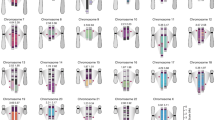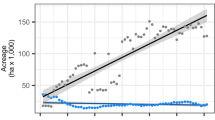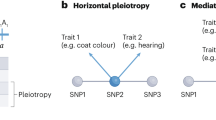Abstract
The use of flanking marker methods has proved to be a powerful tool for the mapping of quantitative trait loci (QTL) in the segregating generations derived from crosses between inbred lines. Methods to analyse these data, based on maximum-likelihood, have been developed and provide good estimates of QTL effects in some situations. Maximum-likelihood methods are, however, relatively complex and can be computationally slow. In this paper we develop methods for mapping QTL based on multiple regression which can be applied using any general statistical package. We use the example of mapping in an F2 population and show that these regression methods produce very similar results to those obtained using maximum likelihood. The relative simplicity of the regression methods means that models with more than a single QTL can be explored and we give examples of two linked loci and of two interacting loci. Other models, for example with more than two QTL, with environmental fixed effects, with between family variance or for threshold traits, could be fitted in a similar way. The ease, speed of application and generality of regression methods for flanking marker analyses, and the good estimates they obtain, suggest that they should provide the method of choice for the analysis of QTL mapping data from inbred line crosses.
Similar content being viewed by others
Article PDF
References
Aitkin, M, Anderson, D, Francis, B, and Hinde, J. 1989. Statistical Modelling in GLIM. Oxford University Press, Oxford.
Draper, N R, and Smith, H. 1966. Applied Regression Analysis John Wiley and Sons, New York.
GENSTAT 5 Committee, 1989. Genstat 5 Reference Manual, Clarendon Press, Oxford.
Haldane, J B S. 1919. The combination of linkage values and the calculation of distance between the loci of linked factors. J Genet, 8, 299–309.
Haley, C S. 1991. Use of DNA fingerprints for the detection of major genes for quantitative traits in domestic species. Anim Genet, 22, 259–277.
Knapp, S J. 1991. Using molecular markers to map multiple quantitative trait loci: models for backcross, recombinant inbred, and doubled haploid progeny. Theor App Genet, 81, 333–338.
Knapp, S J, Bridges, W C Jr, and Birkes, D. 1990. Mapping quantitative trait loci using molecular marker linkage maps. Theor App Genet, 79, 583–592.
Knott, S A, and Haley, C S. 1992. Aspects of maximum likelihood methods for the mapping of quantitative trait loci in line crosses. Genet Res 60, (in press).
Lander, E S, and Botstein, D. 1989. Mapping Mendelian factors underlying quantitative traits using RFLP linkage maps. Genetics, 121, 185–199.
Mather, K M, and Jinks, J L. 1982. Biometrical Genetics 3rd edn. Chapman and Hall, London.
McCullagh, P, and Nelder, J A. 1983. Generalized Linear Models. Chapman and Hall, London.
Morton, N E. 1955. Sequential tests for the detection of linkage. Am J Hum Genet, 7, 277–318.
Paterson, A H, Damon, S, Hewitt, J D, Zamir, D, Rabinowitch, H D, Lincoln, S E, Lander, E S, and Tanksley, S D. 1991. Mendelian factors underlying quantitative triats in Tomato: Comparison across species, generations and environments. Genetics, 127, 181–197.
Patterson, H D, and Thompson, R. 1971. The recovery of inter-block information when block sizes are unequal. Biometrika, 58, 545–554.
Weller, J I. 1987. Mapping, and analysis of quantitative trait loci in Lycopersicon (tomato) with the aid of genetic markers using approximate maximum likelihood methods. Heredity, 59, 413–421.
Wilks, S S. 1938. The large sample distribution of the likelihood ratio for testing composite hypotheses. Ann Math Stat, 9, 60–62.
Author information
Authors and Affiliations
Rights and permissions
About this article
Cite this article
Haley, C., Knott, S. A simple regression method for mapping quantitative trait loci in line crosses using flanking markers. Heredity 69, 315–324 (1992). https://doi.org/10.1038/hdy.1992.131
Received:
Issue Date:
DOI: https://doi.org/10.1038/hdy.1992.131
Keywords
This article is cited by
-
Validation of quantitative trait loci for biofortification traits and variability research on agro-morphological, physiological, and quality traits in dicoccum wheat (Triticum dicoccum Schrank.)
Genetic Resources and Crop Evolution (2024)
-
Mapping and validation of Fusarium wilt race 2 resistance QTL from Citrullus amarus line USVL246-FR2
Theoretical and Applied Genetics (2024)
-
Efficiency of mapping epistatic quantitative trait loci
Heredity (2023)
-
Wheat (Triticum aestivum) chromosome 6D harbours the broad spectrum common bunt resistance gene Bt11
Theoretical and Applied Genetics (2023)
-
Genetic analysis of quantitative variation in almond nut traits
Tree Genetics & Genomes (2023)



